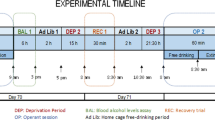Abstract
Earlier we showed that direction of changes in the initial anxiety level during compulsory alcoholization was more essential for development of alcohol preference than the initial anxiety level per se. The goal of this work was to study effect of the anxiety level changes on development of ethanol preference in Wistar male rats pharmacologically affected by phenazepam and caffeine. Out of four groups (60 rats) over the period of 4 months, group I had access to 10% ethanol, group II-to 10% ethanol with 0.4 g/l caffeine, group III-to 10% ethanol with 0.5 mg/l phenazepam, and group IV (control)—to water only. The anxiety level and behavioral parameters were evaluated before the onset of the experiment and every 5 weeks thereafter by using the open field test. The ethanol preference was determined by the 2-glass test before the onset of the experiment and every 4 weeks thereafter. In the experimental groups, the long-term consumption of ethanol, ethanol with caffeine, and ethanol with phenazepam led to an increase in alcohol preference as compared with control. A decrease in motor activity under compulsory alcoholization was found to correlate positively with the low level of alcohol preference. Rats that consumed ethanol with caffeine sensitive to this anxiety-enhancing psychostimulant developed ethanol preference faster. The rats insensitive to caffeine developed no alcohol preference. The rats sensitive to the sedative effect of phenazepam were less anxious and did not prefer alcohol subsequently. In rats insensitive to phenazepam, anxiety increased and alcohol preference developed.
Similar content being viewed by others
References
Shabanov, P.D. and Kalishevich, S.Yu., Biologiya alkogolizma (Biology of Alcoholism), St. Petersburg, 1998.
McBride, W.J. and Li, T.K., Animal models of alcoholism: neurobiology of high alcohol-drinking behavior in rodents, Crit. Rev. Neurobiol., 1998, vol. 12, pp. 339–369.
Schukit, M.A., Drug and Alcohol Abuse. A Clinical Guide to Diagnosis and Treatment, 5th Ed., N.Y., 2000.
Weiss, F. and Porrino, L.J., Behavioral neurobiology of alcohol addiction: recent advances and challenges, J. Neurosci., 2002, vol. 22, pp. 3332–3337.
Savonenko, A.V., Adrianov, O.S., Nikolskaya, K.U., Osipov, A.I., and Eshchenko, O.V., Psychophysiological markers of predisposition to development of alcohol dependence in rats, Zh. Vyssh. Nervn. Deyat., 1995, vol. 45, pp. 416–419.
Tabakoff, B. and Hoffman, P., Animal models in alcohol research, Alcohol Res. Health, 2000, vol. 24, pp. 77–84.
Blatt, S.L. and Takahashi, R.N., Experimental anxiety and the reinforcing effects of ethanol in rats, Brazil. J. Med. Biol. Res., 1999, vol. 32, pp. 457–461.
Stewart, R.B., Gatto, G.J., Lumeng, L., Li, T.K., and Murphy, J.M., Comparison of alcohol-preferring (P) and non-preferring (NP) rats on tests of anxiety and for the anxiolytic effects of ethanol, Alcohol, 1993, vol. 10, pp. 1–10.
Tuominen, K., Hilakivi, L.A., Päivärinta, P., and Korpi, E.R., Behavior of alcohol-preferring AA and alcohol-avoiding ANA rat lines in tests of anxiety and aggression, Alcohol, 1990, vol. 7, pp. 349–353.
Filatova, E.V., Egorov, A.Yu., Kucher, E.O., and Kulagina, K.O., The effect of emotional individuality on development of ethanol preference in Wistar female and male rats, Zh. Evol. Biokh. Fiziol., 2011, vol. 47, no. 5, pp. 404–410.
Rail, T.W., Central nervous system stimulants: the methylxanthines, The Pharmacological Basis of Thera peutics. 7th Edition, Goodman, G.A., Goodman, L.S., Rail, T.W., and Murad, F., Eds., N.Y.: Macmillan Publishing Company, 1985, pp. 589–603.
Attwood, A.S., Rogers, P.J., Ataya, A.F., Adams, S., and Munaf, M.R., Effects of caffeine on alcohol-related changes in behavioural control and perceived intoxication in light caffeine consumers, Psychopharmacol., 2012, vol. 221, no. 4, pp. 551–560.
Epstein, O.I., Voronina, T.A., Molodavkin, G.M., Belopol’skaya, M.V., Kheyfets, I.A., Dugina, J.L., and Sergeeva, S.A., A study of bipathic effect of phenazepam, Byull. Eksper. Biol. Med., 2007, vol. 144, no. 4, pp. 536–538.
Hall, C.S., Emotional behaviour in the rat: I. Defecation and urination as measures of individual differences in emotionality, J. Comp. Psychol., 1934, vol. 18, pp. 385–403.
Kucher, E.O., Egorov, A.Yu., Filatova, E.V., and Kulagina, K.O., The effect of long-term consump tion of ethanol and caffeine on alcohol preference and behavior in male rats, Narkologiya, 2012, no. 3, pp. 28–31.
Kaluev, A.V. and Tuohimaa, P., The Suok test, the new behavioral anxiety model, Neironauki, 2005, no. 1, p. 17.
Kucher, E.O., Egorov, A.Yu., Filatova, E.V., and Kulagina, K.O., A combined consumption of caffeine and ethanol increases alcohol preference in female rats, Narkologiya, 2010, no. 12, pp. 37–40.
Gulick, D. and Gould, T.J., Effects of ethanol and caffeine on behavior in C57BL/6 mice in the plusmaze discriminative avoidance task, Behav. Neurosci., 2009, vol. 123, pp. 1271–1278.
Zakusov, B.V., Lyubimov, B.I., Yavorskii, A.N., and Fokin, V.I., Effect of phenazepam on the ethanol preference in rats, Byull. Eksper. Biol. Med., 1979, vol. 88, no. 7, pp. 32–35.
Burov, I.V., Kampov-Polevoi, A.V., and Nikitina, L.N., Effect of psychotropic substances on the development of alcoholic motivation in outbred white rats, Byull. Eksper. Biol. Med., 1986, vol. 101, no. 3, pp. 289–291.
Golovenko, N.I., Surmak, V.V., Gurman, E. G., and Karaseva, T.L., Phenazepam consumption in rats depends on the degree of alcoholic motivation, Farmakol. Toksikol., 1988, vol. 51, no. 6, pp. 90–92.
Author information
Authors and Affiliations
Corresponding author
Additional information
Original Russian Text © K.O. Kulagina, A.Yu. Egorov, E.V. Filatova, 2014, published in Zhurnal Evolyutsionnoi Biokhimii i Fiziologii, 2014, Vol. 50, No. 2, pp. 130–136.
Rights and permissions
About this article
Cite this article
Kulagina, K.O., Egorov, A.Y. & Filatova, E.V. Pharmacological action of phenazepam and caffeine on emotional sphere changes ethanol preference in Wistar male rats. J Evol Biochem Phys 50, 146–153 (2014). https://doi.org/10.1134/S0022093014020070
Received:
Published:
Issue Date:
DOI: https://doi.org/10.1134/S0022093014020070



